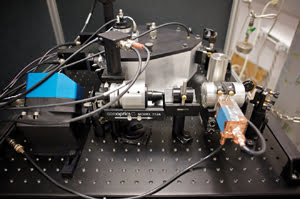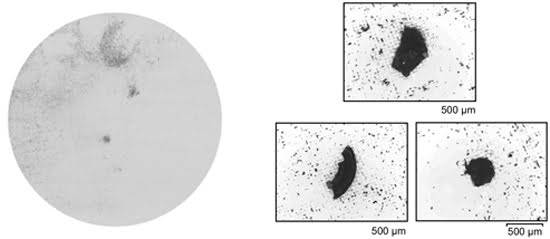Light-driven particle analysis – used in climate change studies, nanotechnology development, semiconductor manufacturing and more – is leading researchers to devise new photonic instruments.
Shane M. Murphy’s research begins with something small but
could end with something big. Murphy, a scientist with the National Oceanic and
Atmospheric Administration (NOAA) in Boulder, Colo., is interested in airborne aerosols.
Along with other researchers there, he wants to probe these particles in the air,
determine their makeup and then tie that data into what satellites see from space.
Doing so would reduce climate change unknowns.
“The aerosol direct effect is one of the bigger uncertainties
in climate change,” Murphy said. “It’s just the direct radiative
impact of aerosols, how they impact how much sunlight hits the surface of the Earth.”
Understanding that requires particle analysis, which has spurred
NOAA researchers to develop specialized photonics-based instruments. Light-driven
particle analysis also plays a key role in the manufacturing of semiconductor and
microelectromechanical systems (MEMS) as well as for emerging nanotech devices.
The same is true for components in the aerospace, automotive, pharmaceutical and
other industries. Particle analysis, however, faces challenges, such as how to increase
its speed or how to get the goods on a sample of individual particles and for the
bulk of a material.

Sampling particles from a construction
site near the Rocky Mountain foothills in Colorado revealed that a few were dark
and heat-absorbing, something that bulk averaging methods might have missed. Courtesy
of NOAA.
In the case of NOAA, the focus on aerosols arises from a need
to determine the optical properties of individual particles. In the 1990s, agency
researchers developed a portable laser ionization mass spectrometer for in situ
measurements of the chemical composition of individual aerosol particles ranging
in size from 0.2 to 3 μm. Versions of the device collected data at locations
around the world.
NOAA scientist and device developer Daniel M. Murphy (no relation
to Shane Murphy) said that the instrument had a compact green laser for particle
counting, a compact excimer laser for particle ionization and a miniature photomultiplier
tube, all of which enabled particle analysis by laser mass spectrometry (PALMS).
“PALMS used some very state-of-the-art technology when it
was developed,” Murphy said. “Much of the laser technology is pretty
routine now.”
Although this approach generated the chemical composition of particles,
it did not determine their ratio of light scattering to extinction. Such single
scattering albedo information is critical to climate models.

NOAA’s Earth System Research Laboratory developed an instrument
that measures a single aerosol particle’s light scattering and absorption
simultaneously to help resolve climate model uncertainties. Courtesy of NOAA.
For this, the researchers developed their own solution, detailing
it in a 2008 Aerosol Science and Technology paper. Deployed in 2010, the system
uses a nozzle to inject particles one at a time into a scattering cell. The device
is equipped with three high-reflectivity mirrors arranged in a triangle. A 672-nm-wavelength
tunable diode laser is locked to create a traveling wave between the mirrors, amplifying
the resulting signal. The ratio of forward to wide-angle scattering provides the
diameter of the submicron particles to within 50 nm and enables detection of albedo
changes of 10 percent or more at a rate of about 20 particles per second.
The device’s performance could be improved by quieter diode
lasers, better locking electronics and improvements in the manufacturing of the
high-reflectivity mirrors. Shane Murphy noted that future needs include making the
device smaller and more portable. There also is a desire to shift to a laser with
a shorter wavelength than that of the current red source.

“One of the real big interests scientifically right now
is what organics do, and they’re going to absorb down in the blue wavelengths.
They’re not going to do anything in the red,” he said.
Advances in laser technology mean that this switch can be accomplished
with a change of the laser diode source. Murphy said that a smaller version of the
device will be ready for deployment this year in Barbados to measure dust blown
from the Sahara Desert.
Commercially available photonics-based particle analysis includes
sizing via laser scattering and probing via photoacoustics, which involves the rapid
heating of particles and detection of the sounds generated. The technique produces
information about particle composition, since both heating and cooling are influenced
by particle makeup.

Oil about to be filtered and residual particles analyzed. Courtesy
of Olympus Soft Imaging Solutions GmbH.
Other commercial instruments analyze particles by looking at them
via optical microscopy. A typical setup involves a microscope, a camera and software.
In a common application, an object of interest – such as a fuel injector –
is manufactured and rinsed. The liquid is drained and sent through a filter paper,
trapping any particles. The particle analyzer is then used to examine the filter
paper, allowing particles to be spotted, counted, sized and potentially classified
based on shape, reflectivity under various conditions, or other parameters. There
often is a specification about the number of allowable particles, their size or
other characteristics.
Mario J. Gislao, an industrial marketing and applications specialist
with Center Valley, Pa.-based Olympus America Inc., said that this quantifying of
cleanliness is done on his company’s products using white light inspection
spanning 400 to 700 nm. The image from one field of view is captured, and then the
motorized stage moves to the next field of view, with this continuing until the
filter is covered.
“It creates essentially a panoramic image of that whole
filter. What we’re doing is analyzing each of the independent frames for particles,
and the way we do that is based on the gray-scale or color values,” Gislao
said.

Panoramic view of a 47-mm filter after an optical scan (left), with examples of the particles found
(right). Courtesy of Olympus Soft Imaging Solutions GmbH.
If the filter is white, a black particle will show up readily
against it. But because a whiter particle will have a much different gray scale,
the system must be trained to a given application. Typically, the particles of interest
measure a few microns or larger and are easily visible under the microscope using
bright-field imaging. Additional scattering, and therefore composition, information
can be gleaned by dark-field inspection, but at a loss of size data.
Tom Calahan, product materials microscopy marketing manager at
Carl Zeiss USA of Thornwood, N.Y., noted that the trend has been for analysis to
be done on smaller and smaller particles. Beyond a simple count of those above a
certain size, the analysis may involve classifying them as to shape, with, for example,
long and narrow particles indicating a different problem than would be the case
for spherical particles. Another distinction might be to categorize particles as
metallic or nonmetallic.
But this push toward analysis of smaller particles comes at a
cost. It may require imaging at a higher resolution, which also will force the use
of a smaller field of view. Because the area of the filter is not changing, shrinking
the field size means that more fields must be scanned, and the scanning time hit
can mount rapidly.
“If you double the resolution, you quadruple the time, effectively,”
Calahan said.
Vendors are aware of this and are attacking many areas to eliminate
bottlenecks. The list includes camera capture, image transfer, autofocus and stage
movement times. In shaving time off, however, any gains must be balanced against
performance hits.
There has been a tenfold increase in speed over the past few years,
and the expectation is that further increases are in the offing, said Wayne A. Buttermore,
marketing manager for industrial microscopy at Leica Microsystems AG in Bannockburn,
Ill. In part, this is because greater computing power, along with cheaper memory,
will make image processing faster.
He also noted that there will be increasing automation, which
can show up in a number of ways. One is through wizards, software that guides end
users through the steps needed to implement a given task. Another is through taking
actions that ensure reproducible results. These go beyond setting illumination,
camera gain and other parameters to some predefined value.
“One of the modules that we offer with the microscope allows
an individual to select an image that they worked with in the past and actually
recall all of the camera and microscope settings to that exacting, reproducible
standard, and then be able to put a new sample on there or the sample that they
had before and work with it as they had in the past,” Buttermore said.
These instrument speed and capability advances are good news for
those interested in particle analysis, but other improvements are needed, said Hugh
Gotts, director of research and development for Air Liquide’s Fremont, Calif.-based
Balazs Analytical Services, a contract analysis company that services semiconductor,
MEMs, advanced photonics and tool vendors.
Gotts noted that there are many optical scanning techniques that
can determine the position and shape of particles but that are not as good at determining
particle composition. The techniques that are good at composition or molecular analysis,
on the other hand, tend not to be good at finding particles and pinpointing their
location.
Various methods exist to get around this problem, including the
use of spectroscopic libraries against which to compare particle signatures. However,
that approach depends upon the library being complete and the entries distinctive
enough. Another trick is to locate and perhaps size a particle using an optical
scanning method, followed by spectroscopic analysis. Problems may arise, however,
in co-registering the two approaches, or one may actually move or otherwise alter
the particle being analyzed.
In running through a list of techniques that Balazs uses, Gotts
ticked off optical methods, spectroscopy, electron beams and x-rays. Surveying the
group, he said, “There’s no one technique that is optimal for locating,
sizing and identifying particles.”